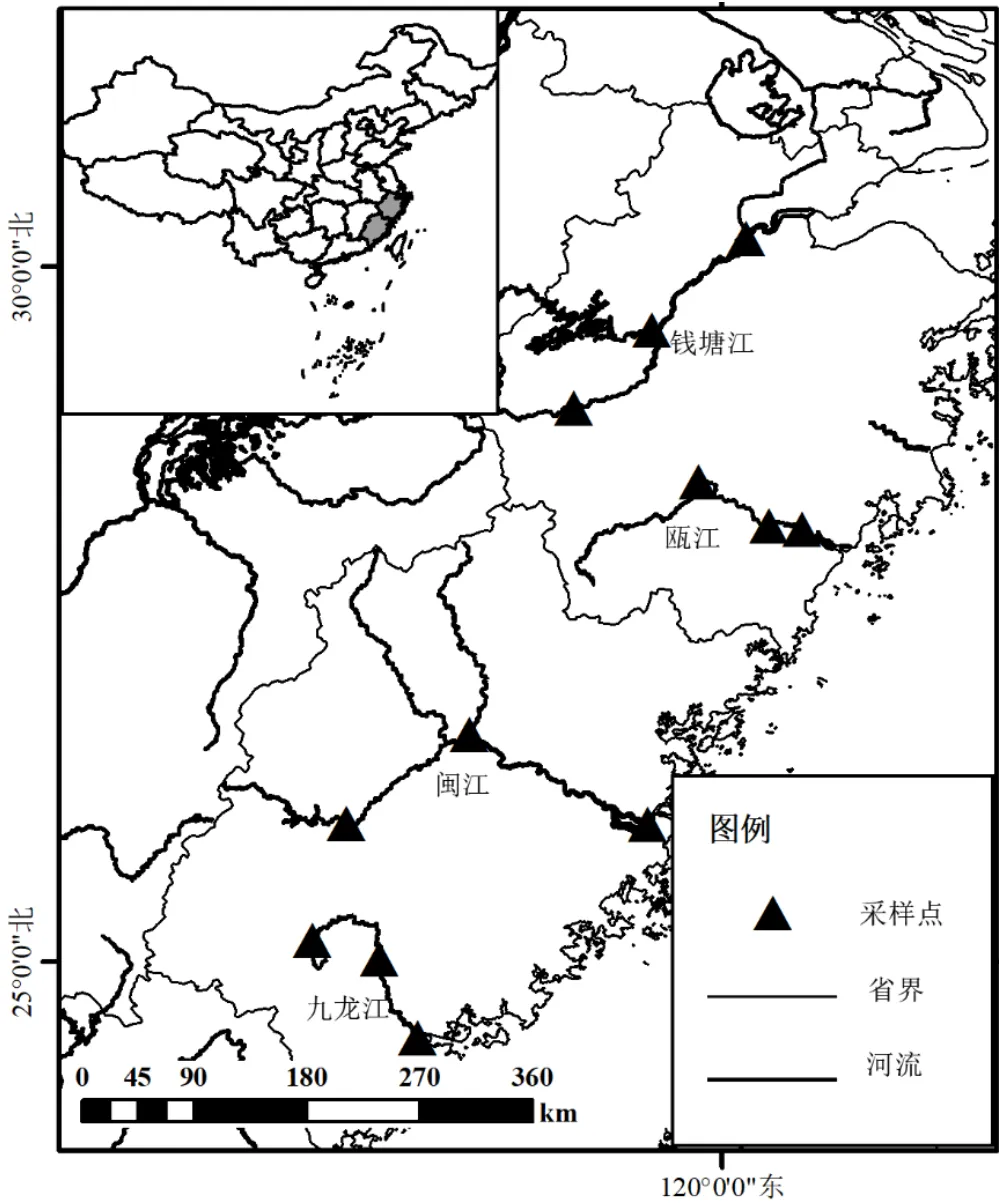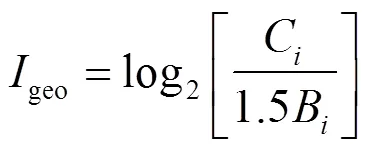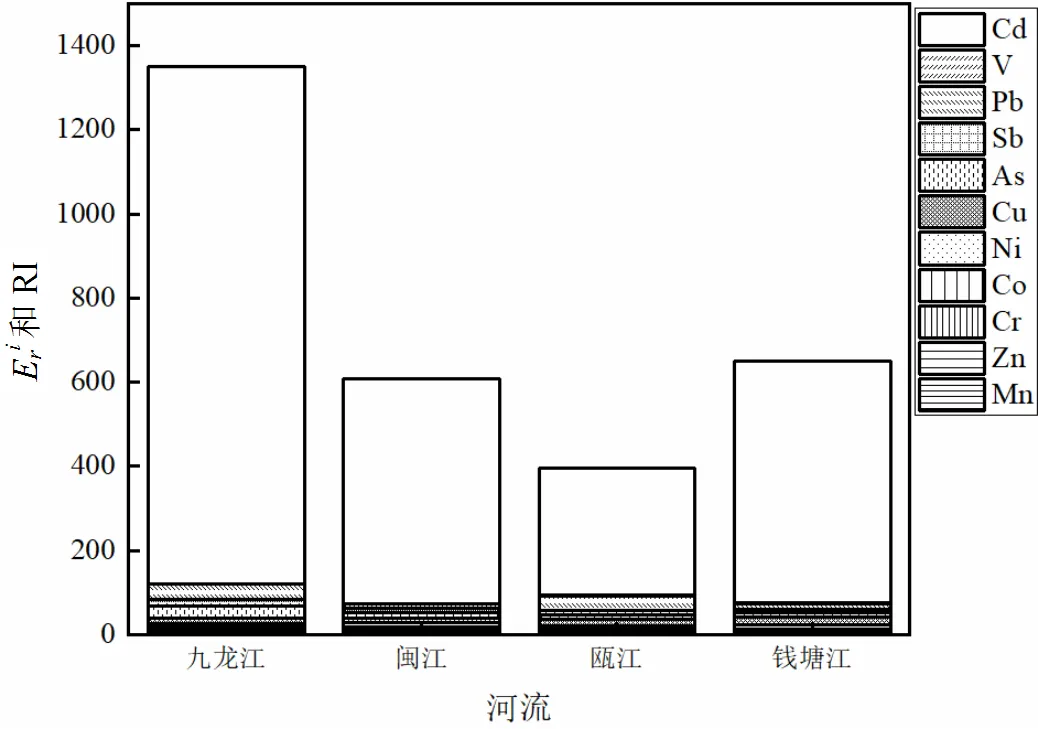南方丘陵区河流表层沉积物重金属污染评价
2019-08-28徐金英郑利林徐力刚王晓龙
徐金英,郑利林,徐力刚,王晓龙*
南方丘陵区河流表层沉积物重金属污染评价
徐金英1,2,郑利林1,2,徐力刚1,王晓龙1*
(1.中国科学院南京地理与湖泊研究所,中国科学院流域地理学重点实验室,江苏 南京 210008;2.中国科学院大学,北京 100049)
采样分析南方丘陵山区瓯江、钱塘江、闽江、九龙江沉积物中重金属含量,并对其来源及生态风险进行研究.结果显示,沉积物中Mn、Zn、As、Cd、Pb、V在九龙江有较高浓度,Ni、Cu在钱塘江浓度最高,Cr、Sb在瓯江浓度最高,而Al、Co和V的最高浓度分布在闽江.但重金属含量空间差异不显著.SQGs、Igeo和EF评价显示,Cd在研究区沉积物中污染最为严重,呈中度至重度污染,其次是Mn、Zn、Pb,其在研究区部分地区存在轻度污染,其他重金属处于无污染状态.RI评价显示,研究区河流沉积物存在极高重金属潜在生态风险,尤其是Cd.相关分析和PCA分析显示,Zn、As、Cd、Pb来自于自然过程、矿业开采及农业生产过程,Cr、Ni、Sb来自于工业生产过程产生废水,Al、Co和V来自于自然过程,而Cu则来源于混合源.pH值、TP、TN和LOI是影响水体中重金属含量的重要因子.本研究为河流生态系统的健康和保护提供重要依据.
东南丘陵山区;河流;沉积物;重金属;生态风险评价;来源解析
重金属具有毒性、持久性和生物聚集性,水生生态系统因其重金属污染在全球范围内备受关注[1-2].水生生态系统重金属可来自自然过程和人类活动.随着社会经济快速发展,人类活动取代自然过程成为水生生态系统重金属污染的主要来源[3].重金属进入水体后,最终会通过吸附于细颗粒物等方式沉淀入表层沉积物[4].但理化环境或水文条件发生变化时,沉积物会生再悬浮,从而造成二次污染[7-8].因此,有必要掌握表层沉积物中重金属的分布及污染状况[9],为水环境保护提供有效基础和依据.
河流在提供水资源、防洪、灌溉、水产养殖、气候调节和维持生态系统平衡等各个方面发挥重要作用[10].但来自自然过程及人类活动的污染物使世界各地河流遭受不同程度重金属污染[11-13].目前关于河流表层沉积物中重金属研究主要集中于三个方面:一是通过地累积指数(geo)、富集指数(EF)等评价指数对表层沉积物重金属污染程度进行评价[14];二是通过潜在风险指数(RI)对表层沉积物重金属潜在风险进行分析[15];三是通过相关分析、主成分分析(PCA)等[16]多元统计以及同位素示踪[17]等方法对重金属来源进行源解析.
福建浙江两省是中国东南丘陵山区重要省份.因其地理位置、资源优势社会经济得到快速发展,但同时也使得其主要河流(主要为九龙江、闽江、瓯江、钱塘江)受到不同程度重金属污染[18-21].如,已有研究显示九龙江表层沉积物中Pb、Cd、Co、Zn、和Cu具有较高生态风险[22],而闽江、钱塘江和瓯江沉积物受到Cd、Pb、Zn等重金属污染[23,20-21].基于此,本研究综合评价福建浙江两省主要四条河流表层沉积物重金属污染情况,并对其来源进行比较分析.
1 材料与方法
1.1 研究区概况
研究区位于南岭以南,年均温度为18℃,年降水量为1250mm,降水主要集中在5~8月.所研究四条河流均为流域经济发展重要水源。闽江为福建省最大河流,全长541m,流域面积60992km[20-21].九龙江是福建省第二大河流,属于典型亚热带中小流域,流域面积为1.47´104km2;流域内矿产资源种类多,储量丰富[17-18,24].钱塘江位于浙江省西北部,是浙江省内最大河流,流域面积达55558km2,流域内人口约为2699.3万人,占浙江省总人口55.55%[25].瓯江位于浙江省南部,是浙江省第二大河,长达388km,流域面积18028km2,上游是重要的水电开发地区,下游是浙江省主要工农业经济区[21].
1.2 研究方法
1.2.1 样品采集与处理 于2015年1月,用不锈钢采泥器从瓯江、钱塘江、九龙江和闽江4条河流上、中和下游分别采集表层沉积物(0~10cm)样品.每个采样点采集5个点(5m左右间距)作为混合样,每条河流设3个样点(图1).所有样品放置在酸洗聚乙烯塑料带运输到实验室中,-20℃保存,待进一步分析.
1.2.2 样品分析与质量控制 所有沉积物样品理化指标及重金属指标均在中科院南京地理与湖泊研究所国家重点实验室测定.用于测定重金属的沉积样品经冻干、研磨和过100目筛.每个样品称量0.12g,在HCl-HNO3-HF-HClO4消解系统中消解.重金属Mn、Zn、Cr、Co、Ni、Cu、As、Cd、Sb、Pb和V浓度用电感耦合等离子体质谱法(ICP-MS, 7700x, NYSE: A,美国)测定.重金属最低测定值分别为0.05mg/kg, 0.2mg/kg, 0.1mg/kg, 0.01mg/kg, 0.05mg/ kg, 0.02mg/kg, 0.1mg/kg, 0.01mg/kg, 0.05mg/kg, 0.02mg/kg和0.1mg/ kg.Al采用电感耦合等离子体原子发射光谱法(ICP- AES, Prdodigy, Teledyne Leeman Labs,美国)方法测定,测定最低20mg/kg.为保证测定重金属数据的质量,在测定过程中设置空白、重复和标准样.每个样品每种重金属测定3个重复,取均值.分析过程用国标GBWO7358进行全程质量监控,测定值和标准值相对标准偏差控制在10%以内.

图1 研究区域及采样点位置
沉积物TN和TP采用过硫酸盐氧化法同时测定;沉积物pH值采用pH计现场测定;沉积物有机质含量(LOI)通过烧失法测定.
1.2.3 污染程度评价方法
(1)用地累积指数法(geo)地累积指数评价重金属污染程度.其计算方式如下[26]:

式中:C为重金属的浓度;B为重金属的地理化学背景值(BG);参数1.5为自然作用可能会对沉积物产生的影响(如岩石风化或者沉积物侵蚀等).由于地理位置的差异,福建和浙江两省河流分别用对应省份的元素背景值,如表1所示[2].

表1 福建和浙江省重金属元素背景值(mg/kg)

表2 Igeo,, EF和RI等级
(2)富集指数(EF)富集指数用来评估人为活动可能会对沉积物中重金属含量产生的影响.计算公式为[7]:

式中:(C/Al)沉积物为沉积物样品中金属浓度(C)与重金属Al浓度(Al)的比值;(C/Al)背景值为重金属背景浓度(C)与Al背景浓度(Al)比值.





所有评价指标等级如表2所示.
1.3 统计分析方法
通过Pearson相关分析和主成分分析(PCA)分析重金属来源.通过冗余分析(RDA)来进一步分析沉积物重金属含量受理化性质的影响.通过单因素方差分析(ANOVA)分析河流之间重金属含量的差异性.
2 结果与分析
2.1 沉积物理化性质变化
表3为河流沉积物基本理化性质特征.pH值均值为7.60,最大值在九龙江下游,最小值在九龙江上游.TN变化范围为1.70~7.19mg/kg,最大值在闽江中游,最小值在瓯江中游.TP浓度范围为0.63~ 4.49mg/kg,在闽江中游浓度显著较高,在钱塘江上游、闽江上游和瓯江上游显著较低.LOI含量范围为2.02%~7.65%,在闽江中游含量最高,九龙江中游、瓯江中下游含量最低.

表3 河流沉积物理化性质基本特征
2.2 沉积物重金属浓度特征
研究区沉积物Al、Mn、Zn、Cr、Co、Ni、Cu、As、Cd、Sb、Pb和V的平均浓度分别为76.65, 1470.2, 246.10, 90.64, 12.44, 35.33, 54.80, 11.83, 1.60, 1.18, 146.86, 71.07mg/kg.与国内外规范及河流比较显示(表4),所有重金属浓度均高于TEL和UCC;且除Co以外,所有重金属浓度均高于USEPA. Zn、Cd、Pb浓度略高于PEL,Zn、Cr、Cd、Pb浓度超过中国土壤环境质量二级标准.且研究区所有重金属浓度均高于长江和珠江(除As外);且除Co、Cu和As外所有重金属浓度均高于饶河.

表4 研究区河流沉积物重金属含量与规范及其他研究的对比(mg/kg)
注:TEL表示高于此浓度重金属不利影响可能会发生;PEL表示高于此浓度重金属不利影响会频繁发生;UCC表示陆地地壳重金属浓度值;USEPA表示美国淡水系统水体重金属浓度毒性限值.
2.3 沉积物重金属空间分布特征
如图2所示, Mn、Zn、As、Cd、Pb在九龙江浓度较高,分别为2684.28, 372.74, 17.79, 3.03, 296.42mg/kg,且在九龙江上游浓度最高,分别为5617.12, 678.88, 28.20, 7.17, 724.65mg/kg. Ni、Cu在钱塘江浓度最高,分别为44.11, 69.13mg/kg,且在钱塘江中游明显浓度最高,分别为89.88, 160.63mg/kg. Cr、Sb在瓯江浓度最高,分别为125.03, 1.63mg/kg,且Cr在瓯江下游浓度最高,为146.45mg/kg,而Sb在上游浓度最高,浓度为3.55mg/kg.Al、Co和V的最高浓度分布在闽江,浓度分别为84.26, 16.46mg/kg和91.51mg/kg.


图2 重金属在河流沉积物中的分布
2.4 沉积物重金属污染评价
2.4.1geo评价Cd在4条河流沉积物中geo值排序为九龙江(4.02)>钱塘江(3.20)>闽江(3.18)>瓯江(2.70)(图3).其他重金属geo值均<1.
2.4.2 EF评价 Cd在4条河流中EF顺序为:九龙江(31.62)>钱塘江(14.47)>闽江(11.58)>瓯江(7.40)(图4).Mn和Zn在九龙江EF值分别为5.23和3.26.Pb在九龙江和瓯江EF在3~5之间.一些河流重金属EF值在1~3之间:如瓯江、闽江和钱塘江重金属Mn和Zn、闽江和钱塘江重金属Pb等.重金属在其他河流中重金属EF值均小于1.


图3 重金属在河流沉积物中的Igeo值

图4 重金属在河流沉积物中的EF值
2.5 沉积物重金属潜在生态风险评价
2.6 沉积物重金属来源分析
2.6.1 相关分析 相关分析显示,Mn、Zn、As、Cd、Pb之间显著相关;Cr、Ni、Sb之间显著相关;Co和V显著相关;而Cu和Zn, Co, Ni, Cd, V显著相关;而Al不和任何重金属的相关性显著.
2.6.2 PCA分析 PCA分析将重金属分为3个主成分,解释总方差的87.05%.第一主成分解释总方差的48.25%,与Mn、Zn、As、Cd、Pb显著相关.第二主成分解释总方差的24.52%,与Cr、Ni、Cu、Sb显著相关.第三主成分解释总方差的14.29%,与Al、Co、V显著相关.

表5 河流沉积物重金属含量相关性分析
注:* 在0.05水平(双侧)上显著相关.** 在0.01水平(双侧)上显著相关.

图5 河流表层沉积物重金属Eri和RI值
每个点位RI值为所有重金属E值之和

图6 河流沉积物重金属与理化性质RDA分析
2.6.3 RDA分析 RDA前两轴的特征值分别为0.267和0.056,解释总方差的32.4% (图6).第一轴解释总方差的26.7%,主要载荷重金属为Mn、Pb、As、Cd、Zn、Co、V、Cu,与pH值存在显著正相关(=0.624),与TP存在负相关(-0.20).第二轴解释总方差的5.7%,主要载荷重金属为Sb、Ni、Al、Cr,与TN(=0.27)和LOI(=0.38)存在正相关.

表6 河流沉积物重金属主成分分析
3 讨论
重金属污染是福建浙江河流面临的重要问题,其可能来源于自然过程,如岩石风化、水文侵蚀等,也可能来源于人类活动,如农业活动、工业生产、城市建设与发展及日常生活.本研究中,某些重金属在沉积物中浓度较高,如Mn、Zn、As、Cd、Pb、V在九龙江,Cu、Ni在钱塘江,Cr、Sb在瓯江,Al、Co和V在闽江浓度较高.由于区域气候和地形环境具有相似性,人类活动可能在重金属空间分布方面起着重要作用.福建和浙江两省均为东部省份,自然条件相似,相对于中西部省份,第二、三产业是其优势产业,因此工业发展、服务业发展可能是导致其重金属污染的主要原因[2,25].钱塘江流域分布有大量电镀、化工等工业制造业[25],这可能是Cu和Ni在此流域浓度较高的原因.九龙江流域经济发展较好,其覆盖的主要城市工业产业比值均在50%左右[35].九龙江上游矿产资源丰富,如龙岩新罗区马坑和潘洛铁矿区,龙岩竹子板锰矿区等[24],这些矿产资源伴有大量Zn、Pb、Cd、As等金属[36].近年来的矿业开采和工业废水排放可能是造成这些重金属污染的重要原因.闽江流域经济总量达到全省的40%,流域中上游化工煤炭等重工业,下游机械、电子等产业以及中下游农业发展可能是重金属Co、V等重金属浓度较高的原因[35].而瓯江下游工业城市如温州的快速发展,可能导致其个别重金属浓度较高[21].
与国内外标准比较及污染评价结果显示,Cd在研究区域污染最为严重,九龙江受到Cd极严重污染,钱塘江和闽江均受到Cd非常严重污染,瓯江受到Cd中等严重程度污染,这与其他研究结果相一致[22]. Cd普遍存在于工业废水及农业生产活动中[37-39],研究河流中下游农业发展及机械、电子、化工等涉及重金属的工业发展可能是造成Cd污染的重要原因.同时,RI健康风险评价显示,Cd在所有河流中生态风险极高,这与已有研究一致[23].Cd浓度很低,生态风险却极高,这一方面是因为Cd本身毒性比较高,另一方面可能是因为Cd主要以溶解态为主[40].研究区Cd的高生态风险机制有待进一步研究.
通过PCA分析结果显示,第一主成分主要包括Mn、Zn、As、Cd、Pb 5种重金属,相关分析显示此5种重金属具有显著相关性,说明其有共同来源.Mn是自然界中广泛存在的重金属,说明其可能存在于自然源;而I和EF评价显示,河流中Mn也可能来自于人类活动,研究区有大量Mn矿产资源分布,如九江上游Mn矿[24],且这些矿产资源中伴有Zn、As、Cd、Pb等重金属,因此矿产资源开采及相关工业活动可能是这些重金属的主要来源.同时研究显示, Cd,Cu和Pb是当地农业生产过程中使用农药化肥的重要组成部分[41].故第一主成份代表重金属来源可能为自然过程、矿产资源开采和农业生产活动.第二主成分包括Cr、Ni、Cu和Sb,但相关分析显示只有Cr、Ni和Sb是相互显著相关,而Cu和Zn, Co, Ni, Cd, V显著相关,说明Cu具有多元性.4种重金属在浙江钱塘江和瓯江河流浓度相对福建河流闽江和九龙江浓度高.Cr,Ni广泛用于电镀、化工、机械等制造工业发展过程中,这与闽江、九龙江沿江工业分布具有一致性.第二主成份重金属可能来源于工业生产过程中产生废水.第三主成分主要包括Al、Co、V 3种元素.I、EF污染评价结果显示Al、Co和V处于无污染状态,故3元素应该主要来自于自然源.Al广泛存在于自然界中,研究区以红壤为主,富含Fe和Al,但是缺乏有机质,这导致土壤很容易被侵蚀进入河流,造成河流沉积物中Al含量比较多[2],故Al可能来自于土壤侵蚀等自然过程.而Co、V和Al无显著相关性,Co和V可能来源于岩石风化等其他自然过程.Cu与三主成分各重金属的相关性,说明Cu是来自于混合源.
RDA分析显示,pH、TN与沉积物重金属含量呈正相关,TP与沉积物重金属含量呈负相关,与已有研究相一致[42-43].研究显示,在富营养化湖泊中,重金属以低价态存在,在贫营养化湖泊中以高价态存在[4].也有研究显示营养盐对重金属的影响与季节等其他因子也有关系[44].故营养物质对研究区重金属的影响有待进一步研究.也有研究显示pH值是影响水体沉积物重金属含量的重要因子,与Cd含量存在显著正相关[42-43].有机质含量与重金属含量也呈正相关[45].但是具体机制有待进行研究.
4 结论
4.1 沉积物中, Mn、Zn、As、Cd、Pb在九龙江浓度较高,Ni、Cu在钱塘江浓度最高,Cr、Sb在瓯江浓度最高,而Al、Co和V的最高浓度分布在闽江,重金属含量空间差异不显著.
4.2 SQGs, Igeo和EF评价显示,Cd在研究区沉积物中污染最为严重,呈中度至重度污染,其次是Mn、Zn、Pb,其在研究区部分地区存在轻度污染,其他重金属处于无污染状态.
4.3 RI评价显示,研究区河流沉积物存在极高重金属潜在生态风险,尤其是Cd.
4.4 相关分析和PCA分析显示,Mn、Zn、As、Cd、Pb来自于自然过程、矿业开采及农业生产活动,Cr, Ni,Sb来自于工业废水,Al,Co和V来自于自然过程,而Cu则来源于混合源.pH、TP、TN和LOI是影响水体中重金属含量的重要因子.
[1] Ten H T E M, Mol G A J, Luers F. Release of metals from polluted sediments in a shallow lake quantifying resuspension [J]. Hydrobiologia, 1992,235-236:97-105.
[2] Wang X L, Zhang L, Zhao Z H, et al. Heavy metal pollution in reservoirs in the hilly area of southern China: Distribution, source apportionment and health risk assessment [J]. Science of the Total Environment, 2018,634:158-169.
[3] Hajigholizadeh M, Melesse A M. Assortment and spatiotemporal analysis of surface water quality using cluster and discriminant analyses [J]. Catena, 2017,151:247-258.
[4] Hasegawa H, Rahman M A, Kitahara K, et al. Seasonal changes of arsenic speciation in lake waters in relation to eutrophication [J]. Science of the Total Environment, 2010,408(7):1684-1690.
[5] Fu J, Zhao C P, Luo Y P, et al. Heavy metals in surface sediments of the Jialu River, China: Their relations to environmental factors [J]. Journal of Hazardous Materials, 2014,270:102-109.
[6] Yu C, Zhang J, Wu L, et al. Effects of heavy metal and nutrients on benthic microbial communities in freshwater sediment of poyang lake (China) [J]. Journal of Residuals Science & Technology, 2015,12(2): 105-111.
[7] Zahra A, Hashmi M Z, Malik R N, et al. Enrichment and geo-accumulation of heavy metals and risk assessment of sediments of the Kurang Nallah—Feeding tributary of the Rawal Lake Reservoir, Pakistan [J]. Science of the Total Environment, 2014,470-471: 925-933.
[8] Zhang C, Yu Z G, Zeng G M, et al. Effects of sediment geochemical properties on heavy metal bioavailability [J]. Environment International, 2014,73:270-281.
[9] Dai L J, Wang L Q, Li L F, et al. Multivariate geostatistical analysis and source identification of heavy metals in the sediment of Poyang Lake in China [J]. Science of the Total Environment, 2018,621:1433- 1444.
[10] Xu Y F, Wu Y, Han J G, et al. The current status of heavy metal in lake sediments from China: Pollution and ecological risk assessment [J]. Ecology and Evolution, 2017,7(14):5454-5466.
[11] Islam M S, Ahmed M K, Raknuzzaman M, et al. Heavy metal pollution in surface water and sediment: A preliminary assessment of an urban river in a developing country [J]. Ecological Indicators, 2015,48:282-291.
[12] Sun Z, Mou X, Tong C, et al. Spatial variations and bioaccumulation of heavy metals in intertidal zone of the Yellow River estuary, China [J]. Catena, 2015,126:43-52.
[13] Wang Q, Liu R, Men C, et al. Spatial-temporal distribution and risk assessment of mercury in different fractions in surface sediments from the Yangtze River estuary [J]. Marine Pollution Bulletin, 2017,124(1): 488-495.
[14] Pandey L K, Park J, Son D H, et al. Assessment of metal contamination in water and sediments from major rivers in South Korea from 2008 to 2015 [J]. Science of the Total Environment, 2019, 651(1):323-333.
[15] Han D M, Cheng J P, Hu X F, et al. Spatial distribution, risk assessment and source identification of heavy metals in sediments of the Yangtze River Estuary, China [J]. Marine Pollution Bulletin, 2017, 115(1/2):141-148.
[16] Giri S, Singh A K. Risk assessment, statistical source identification and seasonal fluctuation of dissolved metals in the Subarnarekha River, India [J]. Journal of Hazardous Material, 2014,265(2):305-314.
[17] Bing H, Zhou J, Wu Y, et al. Current state, sources, and potential risk of heavy metals in sediments of Three Gorges Reservoir, China [J]. Environmental Pollution, 2016,214:485-496.
[18] 张 莉,祁士华,瞿程凯,等.福建九龙江流域重金属分布来源及健康风险评价[J]. 中国环境科学, 2014,34(8):2133-2139. Zhang L, Qi S H, Qu C K, et al. Distribution, source and health risk assessment of heavy metals in the water of Jiulong River, Fujian [J]. China Environmental Science, 2014,34(8):2133-2139.
[19] 陈秀玲,卓明清,贾丽敏,等.闽江表层沉积物重金属污染分布特征及其来源分析[J]. 环境污染与防治, 2014,(5):43-48. Chen X L, Zhuo M Q, Jia L M, et al. Distribution and sources of heavy metals pollution in surficial sediments of Minjiang River [J]. Environmental Pollution & Control, 2014,(5):43-48.
[20] 杨 强,刘明亮,韩轶才,等.钱塘江沉积物重金属污染源解析及生态风险评价[J]. 环境科学与技术, 2017,40(12):278-283. Yang Q, Liu M L, Han Y C, et al. Source Identification and Ecological Risk Assessment of Heavy Metals in Sediments of Qiantang River [J]. Environmental Science and Technology, 2017,40(12):278-283.
[21] 车继鲁,余树全,张 鑫,等.瓯江下游流域河流沉积物重金属污染特征、来源及潜在生态风险评价[J]. 生态科学, 2017,36(4):176-184. Che J, Yu S, Zhang X, et al. Pollution characteristics, sources and potential ecological risk of heavy metals in surface sediment from the Lower Ou River [J]. Ecologic Science, 2017,36(4):176-184.
[22] 林承奇,胡恭任,于瑞莲,等.九龙江表层沉积物重金属赋存形态及生态风险[J]. 环境科学, 2017,(3):1002-1009. Lin C Q, Hu G R, Yu R L, et al. Speciation and Ecological Risk of Heavy Metals in Surface Sediments from Jiulong River [J]. Environmental Science, 2017,38(3):1002-1009.
[23] 李 洋,陈卫锋,魏 然,等.闽江福州段沉积物中重金属的分布特征及其毒性和生态风险评价[J]. 环境科学学报, 2016,36(5):1792- 1799. Li Y, Chen W F, Wei R, et al. Distribution characteristics,toxicity and risk assessment of heavy metals in sediments of Minjiang River in Fuzhou City [J]. Acta Scientiae Circumstantiae, 2016,36(5):1792- 1799.
[24] 陈能汪,王德利,鲁 婷,等.九龙江流域地表水锰的污染来源和迁移转化机制[J]. 环境科学学报, 2018,38(8):2955-2964. Chen N W, Wang D L, Lu T, et al. Manganese pollution in the Jiulong River watershed: Sources and transformation [J]. Acta Scientiae Circumstantiae. 2018,38(8):2955-2964.
[25] 郑 洁.钱塘江流域沉积物中重金属总量空间分布及其成因探讨[D]. 上海:华东师范大学, 2016. Zheng J. The research of heavy metals spatial distribution and formation discussion in the drainage basin sediment of Qiantang River [D]. Shanghai: East China Normal University, 2016.
[26] Muller G. Index of geoaccumulation in sediments of the Rhine River. [J]. GeoJournal, 1969,2:108-118.
[27] Zhang P, Qin C, Hong X, et al. Risk assessment and source analysis of soil heavy metal pollution from lower reaches of Yellow River irrigation in China [J]. Science of the Total Environment, 2018,633: 1136-1147.
[28] Macdonald D D, Ingersoll C G, Berger T A. Development and evaluation of consensus-based sediment quality guidelines for freshwater ecosystems [J]. Archives of Environmental Contamination and Toxicology, 2000,39(1):20-31.
[29] Taylor S R. The continental crust: Its composition and evolution, an examination of the geochemical record preserved in sedimentary rocks. [J]. Journal of Geology, 1985,(94):632-633.
[30] US EPA. EPA region III BTAG freshwater sediment screening benchmarks [S]. 2006.
[31] 中华人民共和国环境保护部.土壤环境质量标准(GB 15618-2008) [S]. 2008. People's Republic of China Ministry of Environmental Protection. Environmental quality standard for soils (GB 15618-2008) [S]. 2008.
[32] Zhao G M, Ye S Y, Yuan H M, et al. Surface sediment properties and heavy metal pollution assessment in the Pearl River Estuary, China [J]. Environmental Science and Pollution Research, 2017,24(3):2966- 2979.
[33] Zhang H, Jiang Y, Ding M, et al. Level, source identification, and risk analysis of heavy metal in surface sediments from river-lake ecosystems in the Poyang Lake, China [J]. Environmental Science and Pollution Research, 2017,24(27):21902-21916.
[34] Chai L Y, Li H, Yang Z H, et al. Heavy metals and metalloids in the surface sediments of the Xiangjiang River, Hunan, China: Distribution, contamination, and ecological risk assessment [J]. Environmental Science and Pollution Research, 2017,24(1):874-885.
[35] 李精精.福建九龙江流域产业结构的水环境污染效应[J]. 亚热带水土保持, 2017,29(1):7-11. Li, J J. Pollution effects to water-environment of the industry structure in the Jiulong River watershed of Fujian Province [J]. Subtropical Soils and Water Conservation, 2017,29(1):7-11.
[36] 林长升,张 芸.九龙江流域环境监测与可持续发展[M]. 北京:科学出版社, 2009:21-22. Lin, C S, Zhang, Y. Environmental monitoring and sustainable development in Jiulong River basin [M]. Beijing: Science Press, 2009: 21-22.
[37] 赵中秋,朱永官,蔡运龙.镉在土壤-植物系统中的迁移转化及其影响因素[J]. 生态环境, 2005,(2):282-286. Zhao Z Q, Zhu Y G, Cai Y L. Transport and transformation of cadmium in soil-plant systems and the influence factors [J]. Ecology and Environment, 2005,14(2):282-286.
[38] Gu Y G, Li Q S, Fang J H, et al. Identification of heavy metal sources in the reclaimed farmland soils of the pearl river estuary in China using a multivariate geostatistical approach [J]. Ecotoxicology and Environmental Safety, 2014,105:7-12.
[39] 匡 帅,保琦蓓,康得军,等.典型小型水库表层沉积物重金属分布特征及生态风险[J]. 湖泊科学, 2018,30(2):336-348. Kuang S, Bao Q B, Kang D J, et al. Distribution patterns and ecological risk assessment of heavy metal contamination in surface sediments deposited in a typical small sized water reservoir [J]. Journal of Lake Science, 2018,30(2):336-348.
[40] Xiao Y, Peng B, Yang Z X, et al. Speciation of heavy metals in riverbed sediments of heavy pollution section of the lowermost of the Xiangjiang River [J]. Environmental Chemistry, 2017,36(9):1977- 1986.
[41] 林承奇.九龙江近岸表层沉积物微量元素分布特征及来源解析[D]. 厦门:华侨大学, 2017. Lin, C Q. Distribution characteristics and source analysis of trace elements in offshore surface sediments from Jiulong River [D]. Xiamen: Huaqiao University, Xiamen.
[42] Nazeer S, Hashmi M Z, Malik R N. Heavy metals distribution, risk assessment and water quality characterization by water quality index of the River Soan, Pakistan [J]. Ecological Indicators, 2014,43:262- 270.
[43] Bai J, Jia J, Zhang G, et al. Spatial and temporal dynamics of heavy metal pollution and source identification in sediment cores from the short-term flooding riparian wetlands in a Chinese delta [J]. Environmental Pollution, 2016:219.
[44] Hasegawa H, Rahman M A, Matsuda T, et al. Effect of eutrophication on the distribution of arsenic species in eutrophic and mesotrophic lakes [J]. Science of the Total Environment, 2009,407(4):1418-1425.
[45] Hu C, Yang X, Dong J, et al. Heavy metal concentrations and chemical fractions in sediment from Swan Lagoon, China: Their relation to the physiochemical properties of sediment [J]. Chemosphere, 2018,209: 848-856.
Ecological risk assessment and source analysis of heavy metals in surface sediments of rivers located in the hilly area of southern China.
XU Jin-ying1,2, ZHENG Li-lin1,2, XU Li-gang1, WANG Xiao-long1*
(1.Key Laboratory of Watershed Geographic Sciences, Nanjing Institute of Geography and Limnology, Chinese Academy of Sciences, Nanjing 210008, China;2.University of Chinese Academy of Science, Beijing 100049, China)., 2019,39(8):3420~3429
Heavy metals are characterized with toxicity, persistence and bioaccumulation, can exert significant adverse effect on the health of human beings and other organisms through food chain. In aquatic ecosystem, sediment is both the sink and the source of heavy metals. Thus, it’s of great importance to study heavy metals in surface sediment to keep the aquatic ecosystem in good condition. In this study, the spatial distribution, source analysis, and corresponding ecological risk of heavy metals in surface sediments of four main rivers (Minjiang River, Qiantangjiang River, Oujiang River and Jiulongjiang River) in the hilly area of southern China was analyzed. Our results showed that the relative higher values of metal group of Mn-Zn-As-Cd-Pb were observed in Jiulongjiang River. Moreover, the highest values of metal group of Ni-Cu, Cr-Sb, Al-Co-V were found in Qiantangjiang River, Oujiang River and Minjiang River, respectively. However, no significant difference of the heavy mental contents were tested among the four rivers (>0.05). Pollution assessment based on SQGs, Igeo and EF exhibited that sediments were moderately or seriously polluted by Cd and some sites were slightly polluted by Mn, Zn, and Pb. In addition, the RI assessment showed that heavy metals in sediments of our studied rivers posed extreme high potential of ecological risks. Multivariate analysis indicated that Mn, Zn, As, Cd and Pb mainly came from natural process, agricultural and mining activities; Cr, Ni and Sb may mainly come from instrial wastewater While industrial wastewater and Al, Co, V may mainly derived from natural process. And Cu derived from multiple sources above. By RDA analysis, the pH, TP, TN and LOI were the main environmental factors influencing heavy metal concentrations in the sediments. This study can provide important information for the protection of river ecosystem.
southeastern China;rivers;sediments;heavy metals;potential ecological risk;source apportionment
X522
A
1000-6923(2019)08-3420-10
徐金英(1991-),女,河南商丘人,中国科学院南京地理与湖泊研究所博士研究生,研究方向为污染生态学.
2019-01-07
科技服务网络计划项目(KFJ-STS-ZDTP-011);中国科学院战略优先研究项目(XDA19050502)
* 责任作者, 副研究员, wangxl@niglas.ac.cn
